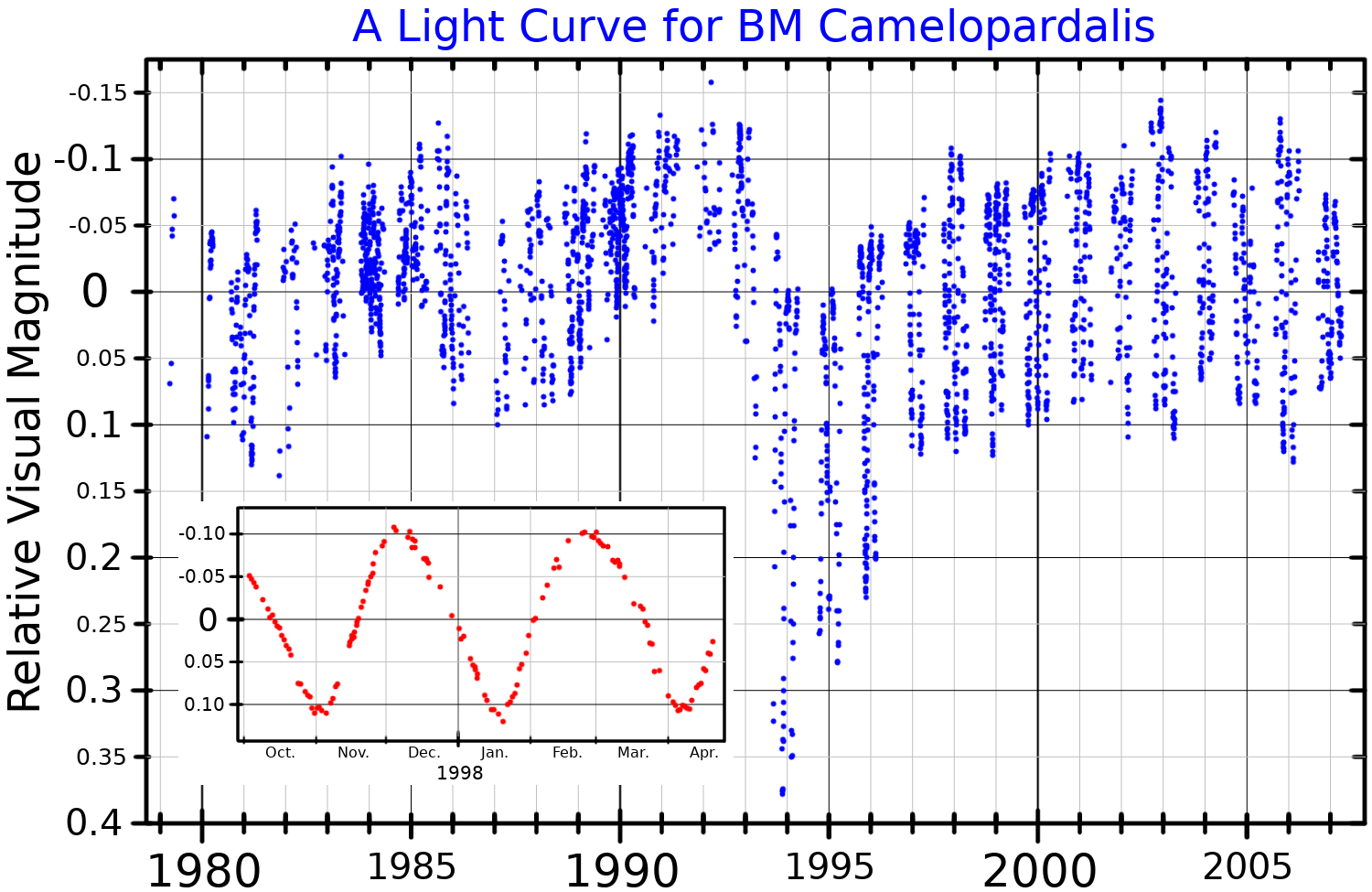12 Camelopardalis on:
[Wikipedia]
[Google]
[Amazon]
12 Camelopardalis is a  Abt et al. (1969) determined this to be a single-lined
Abt et al. (1969) determined this to be a single-lined
binary star
A binary star is a system of two stars that are gravitationally bound to and in orbit around each other. Binary stars in the night sky that are seen as a single object to the naked eye are often resolved using a telescope as separate stars, in wh ...
in the northern circumpolar constellation of Camelopardalis
Camelopardalis is a large but faint constellation of the northern sky representing a giraffe. The constellation was introduced in 1612 or 1613 by Petrus Plancius. Some older astronomy books give Camelopardalus or Camelopardus as alternative for ...
, located 700 light year
A light-year, alternatively spelled light year, is a large unit of length used to express astronomical distances and is equivalent to about 9.46 trillion kilometers (), or 5.88 trillion miles ().One trillion here is taken to be 1012 ...
s away from the Sun as determined from parallax
Parallax is a displacement or difference in the apparent position of an object viewed along two different lines of sight and is measured by the angle or semi-angle of inclination between those two lines. Due to foreshortening, nearby objects ...
measurements. It forms a double star
In observational astronomy, a double star or visual double is a pair of stars that appear close to each other as viewed from Earth, especially with the aid of optical telescopes.
This occurs because the pair either forms a binary star (i.e. a bi ...
with 11 Camelopardalis
11 Camelopardalis is a single star in the northern circumpolar constellation of Camelopardalis, located around 690 light years away from the Sun as determined by parallax. It has the variable star designation BV Camelopardalis; ''1 ...
, which is only 3 arcminutes away. The system has the variable star designation BM Camelopardalis; ''12 Camelopardalis'' is the Flamsteed designation. It is just visible to the naked eye, appearing as a dim, orange-hued star with an apparent visual magnitude of 6.08. The system is moving closer to the Earth with a heliocentric radial velocity
The radial velocity or line-of-sight velocity, also known as radial speed or range rate, of a target with respect to an observer is the temporal rate of change, rate of change of the distance or Slant range, range between the two points. It is e ...
of −2 km/s.
 Abt et al. (1969) determined this to be a single-lined
Abt et al. (1969) determined this to be a single-lined spectroscopic binary
A binary star is a system of two star, stars that are gravity, gravitationally bound to and in orbit around each other. Binary stars in the night sky that are seen as a single object to the naked eye are often resolved using a telescope as separa ...
system and computed an orbital solution with a period of 80.17 days and an eccentricity of 0.35. However, what appeared to be an ellipticity effect with a period of was found, which was inconsistent with the computed orbit, and the lack of modulation of the amplitude did not fit with the large orbital eccentricity. Hall et al. (1995) made additional measurements, finding an orbital period of 80.9 days and an eccentricity that is statistically indistinguishable from zero.
The visible component is an evolved giant star with a stellar classification
In astronomy, stellar classification is the classification of stars based on their stellar spectrum, spectral characteristics. Electromagnetic radiation from the star is analyzed by splitting it with a Prism (optics), prism or diffraction grati ...
of K0 IIIe, showing strong emission lines. It is an RS Canum Venaticorum variable and its brightness varies by 0.14 magnitudes with a period of 82.9 days due to starspots. The star is most likely rotating in synchronous manner with its orbital period. The magnetic activity has two overlapping cycles of 14.8 and 8.5 years, with the activity occurring at two latitudes. BM Cam emits X-rays and is the designated X-ray source 1H 0501+592. It has been detected by HEAO 1, the Einstein Observatory, and ROSAT.
References
{{DEFAULTSORT:12 Camelopardalis K-type giants RS Canum Venaticorum variables Astronomical X-ray sources Spectroscopic binaries Double stars Camelopardalis (constellation) Durchmusterung objects Camelopardalis, 12 032357 0237431623
Events
January–March
* January 21 –
**Viscount Falkland, England's Lord Deputy of Ireland, issues a proclamation ordering all Roman Catholic priests to leave Ireland. The order frustrates negotiations between Protestant En ...
Camelopardalis, BM